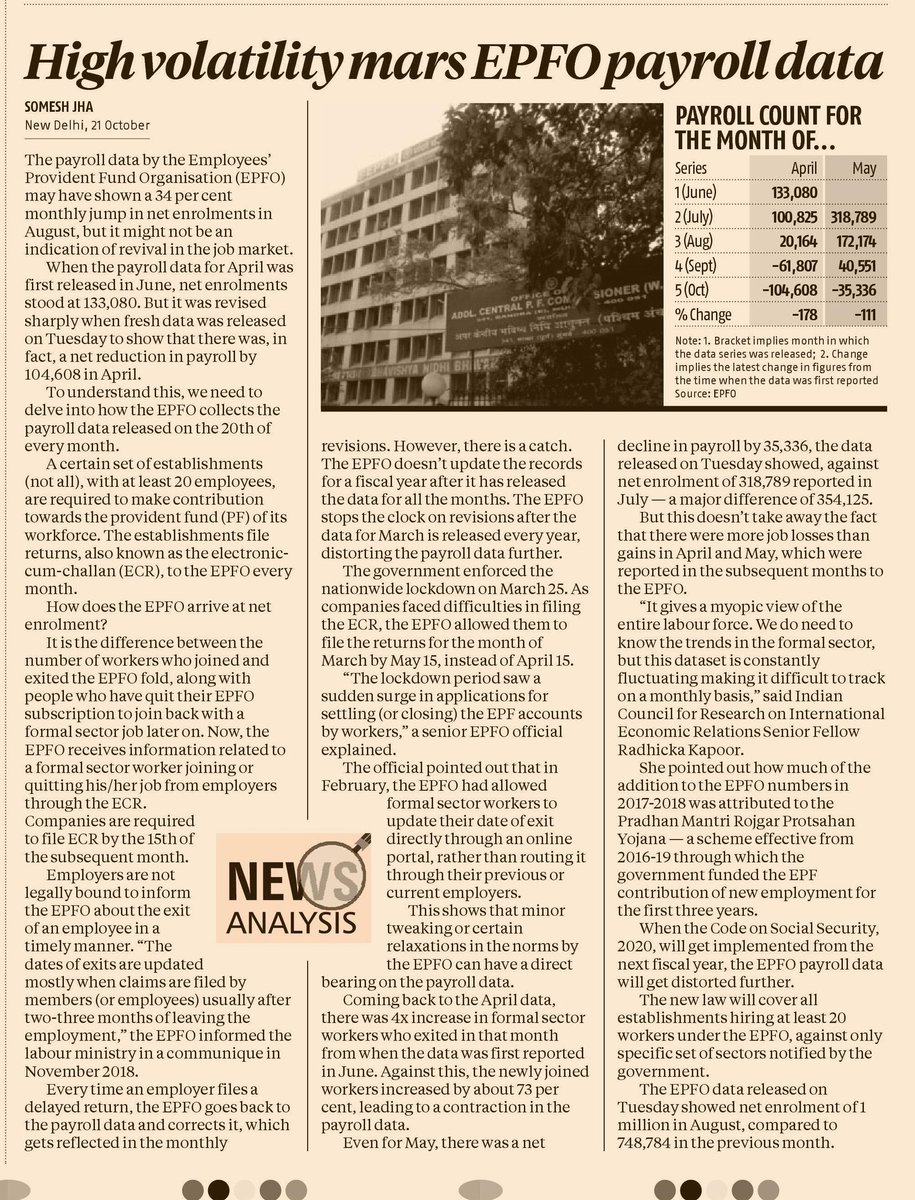EPFO payroll data released on Tuesday showed a big jump of 34% in net enrolments to 1 million in August. Should we see it as an indication of formal sector job market revival? Answer: No
Here& #39;s why: (1/n)
Here& #39;s why: (1/n)
Let& #39;s take the data for April, 2020. When the payroll data for April was first released in June, net enrolments stood at 133,080. But it was revised sharply when fresh data was released on Tuesday to show that there was, in fact, a net reduction in payroll by 104,608. (2/n)
Even for May, there was a net decline in payroll by 35,336, the data released on Tuesday showed, against net enrolment of 318,789 reported in July — a major difference of 354,125. (This is the first time that the EPFO data showed net decline in enrolment for 2 consecutive months)
Why was there sharp revision in the EPFO payroll data?
Net enrolment is the difference between the number of workers who joined and exited the EPFO fold, along with people who have quit their EPFO subscription to join back with a formal sector job later on. (4/n)
Net enrolment is the difference between the number of workers who joined and exited the EPFO fold, along with people who have quit their EPFO subscription to join back with a formal sector job later on. (4/n)
Now, the EPFO receives information related to a formal sector worker joining or quitting his/her job from employers through the returns that they submit, known as ECR. Companies are required to file ECR by the 15th of the subsequent month. (5/n)
Employers are not legally bound to inform the EPFO about the exit of an employee in a timely manner. “The dates of exits are updated mostly when claims are filed by members (or employees) usually after two-three months of leaving the employment,” acc to EPFO (6/n)
Every time an employer files a delayed return, the EPFO goes back to the payroll data and corrects it, which gets reflected in the monthly revisions. However, there is a catch. (7/n)
The EPFO doesn’t update the records for a fiscal year after it has released the data for all the months. The EPFO stops the clock on revisions after the data for March is released every year, distorting the payroll data further and it becomes heavily biased towards joinees (8/n)
The government enforced the nationwide lockdown on March 25. As companies faced difficulties in filing the ECR, the EPFO allowed them to file the returns for March by May 15, instead of April 15. It gave some other relaxations to employers further distorting the database. (9/n)
“The lockdown period saw a sudden surge in applications for settling (or closing) the EPF accounts,” a senior EPFO official explained, adding that it allowed workers to directly inform their date of job exit through online facility in Feb - used by 2.2 million workers. (10/n)
This shows that minor tweaking or certain relaxations in the norms by the EPFO can have a direct bearing on the payroll data, apart from delayed return filing by employers about employment exits (11/n)
When the labour codes will get implemented from the next fiscal year, the EPFO payroll data will get distorted further. The new law will cover all establishments hiring at least 20 workers under the EPFO, against only specific set of sectors notified by the government. (12/n)
. @ishan_83 did an analysis in 2018 of data that suggested that much of the addition to EPFO numbers over past one year was likely to have come from an increase in beneficiaries registered under govt scheme Pradhan Mantri Rojgar Protsahan Yojana (13/n) https://www.business-standard.com/article/economy-policy/is-prime-minister-s-job-generation-scheme-driving-epfo-payroll-data-118112600007_1.html">https://www.business-standard.com/article/e...
Besides, the govt found about 900,000 beneficiaries of the PMRPY were ineligible in the first place as they were part of the formal economy even before the inception of the scheme (all such a/cs were blocked). This data gets captured in payroll. (14/n) https://www.business-standard.com/article/economy-policy/govt-unearths-job-incentive-fraud-epfo-blocks-accounts-of-1-mn-employees-120013000027_1.html">https://www.business-standard.com/article/e...
The problem with the EPFO data is inherent. We reported the same issues in Oct 2018 when data was being revised even after a year of initial public release and it may thow up completely opposite picture of the labour mkt (as we saw for Apr-May 2020) 15/n https://wap.business-standard.com/article/economy-policy/epfo-data-yet-to-stabilise-remains-provisional-in-nature-118102201205_1.html">https://wap.business-standard.com/article/e...
“It gives a myopic view of the entire labour force. We do need to know the trends in the formal sector, but this dataset is constantly fluctuating making it difficult to track on a monthly basis,” said ICRIER Senior Fellow Radhicka Kapoor, who has stopped tracking the data (16/n)
In short, EPFO data is highly volatile - it keeps revising for months. After a point of time, its highly biased towards new joinees (as govt stops updating job losses). The data gets skewed with minor administrative changes.
So, dont read too much into payroll data :)
(17/17)
So, dont read too much into payroll data :)
(17/17)

 Read on Twitter
Read on Twitter



